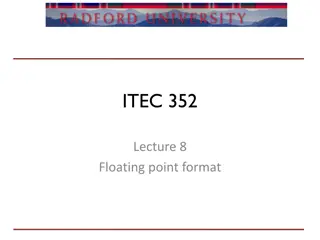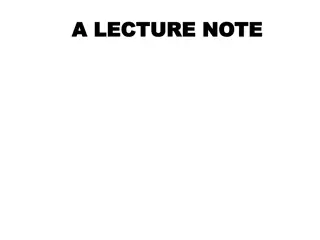Academic Representation at Royal Holloway University
Academic representation at Royal Holloway University plays a crucial role in enhancing the educational experience for students. The system involves various levels of representation with specific responsibilities to ensure effective communication among students, Course Reps, and academic staff. Recen
3 views • 28 slides
Data Representation and Number Systems
This content covers essential topics related to data representation and number systems, including decimal and other bases, binary conversion, ASCII codes, negative numbers, fixed-point and floating-point representations. It discusses how data is internally represented in computers using bits and dif
1 views • 18 slides
Metacentric Height of Floating Bodies
Metacentric height is a crucial measure of a floating body's stability, such as a ship. It refers to the distance between the center of gravity (G) and the metacentre (M). The magnitude of the righting couple and the calculation methods for metacentric height are discussed in detail. Proper design c
1 views • 7 slides
Floating Point Representation of Numbers
Floating point representation is crucial in computer arithmetic operations. It involves expressing real numbers as a mantissa and an exponent to preserve significant digits and increase the range of values stored. This normalized floating point mode allows for efficient storage and manipulation of r
0 views • 12 slides
Overview of MIPS Arithmetic and Logic Instructions in COE 301
MIPS Architecture consists of R-Type and I-Type instruction formats for arithmetic, logical, shift, and immediate constant operations. It includes a variety of general-purpose registers and specific units for execution, floating-point operations, and memory handling. The presentation outlines the st
2 views • 29 slides
Comprehensive Overview of Computer Data Representation and Operations
Delve into the intricate world of computer data representation and micro-operations, covering topics such as binary, octal, and hexadecimal number systems, complements, fixed-point and floating-point representations, arithmetic and logic micro-operations, register transfer language, and more.
1 views • 70 slides
Metacentre in Fluid Mechanics
Metacentre is a crucial concept in fluid mechanics, representing the theoretical point where a displaced body intersects lines passing through the centres of buoyancy and gravity. It is essential for analyzing the stability of floating bodies, especially ships. The metacentric height, the distance b
11 views • 15 slides
Metacentre and Metacentric Height in Fluid Mechanics
Exploring the concept of metacentre in fluid mechanics, where it is the theoretical point that determines the stability of floating bodies. The metacentric height (GM) is crucial in assessing the initial static stability of a floating object. Learn how the metacentre is defined and its significance
0 views • 15 slides
Developments in the Floating Wind Market: Insights and Projections
Exploring the maturation of the floating wind market through historical milestones, current projects in Europe, global pipeline projections, and timelines for upcoming projects. Insights on costs, supply chain, installation, bankability, and risk considerations contribute to understanding the evolut
0 views • 21 slides
Floating Point Representation in Binary Systems
In computer systems, decimal numbers are represented in memory using scientific notation. This involves moving the decimal point and using mantissa and exponent to maintain precision and range. The transition to representing numbers in binary involves multiplying by 2 to the power instead of 10. Uti
2 views • 22 slides
Introduction to Floating Point Data Types and Operations
This content delves into the fundamentals of floating-point data types, focusing on single-precision floating-point formats like float, excess-127, and their characteristics. It also compares float and int32_t data types, detailing the representation and conversion of values between them. The materi
1 views • 46 slides
The Congruence between Elites and Citizens in Representation
The relationship between elites and citizens in representative democracy is explored, tracing historical antecedents, the marriage between representation and democracy, modern representation models, and the roles of representatives. Key themes include responsiveness, responsibility, formalistic, des
0 views • 9 slides
Transforming Urban Aquatoriums Through Pop-Up Approach in Belgrade
Belgrade, known for its floating nightlife venues, faces challenges with existing floating structures. This research explores democratizing aquatoriums through pop-up urbanism, aiming to create a dynamic, inclusive, and sustainable waterfront environment. By reimagining floating architecture as adap
0 views • 14 slides
Division and Floating Point Arithmetic
Explore the concepts of division and IEEE 754 representations in floating point arithmetic. Learn about the processes involved in division, including steps to find quotient and remainder. Delve into an example of dividing numbers along with hardware implementation for efficient division.
0 views • 19 slides
Number Representations and Floating-point Numbers in Computer Science
Exploring the conversion of integers to binary, including the 2's complement method for negative numbers. The concept of fractions in binary and the representation of floating-point numbers in single and double precision formats are also discussed. Special cases like denormalized numbers, infinity,
0 views • 28 slides
Freezing Point Depression and Molality for Solutions
Introduction to molality and freezing point depression in solutions. Molality is a way to measure solution concentration, calculated using moles of solute and kilograms of solvent. By calculating the moles of NaCl in a salt solution and the mass of the solvent (ice/water), the molality can be determ
1 views • 9 slides
Carnegie Mellon Data Representation Recitation Details
Carnegie Mellon's data representation recitation provides a platform for interaction, addressing topics like integers, biasing, endianness, floating point, binary fractions, and the IEEE standard. The agenda includes steps on how to approach the data lab, emphasizing the importance of working on des
0 views • 26 slides
Information Encoding in Computer Organization and Design
Discussions in this lecture delve into the importance and methodology of representing operands in computer systems, covering topics such as encoding characters, integers, positive and negative numbers, fixed-point and floating-point numbers. The motivation behind using binary representation is explo
0 views • 35 slides
Emerging Variable Precision Formats in Compiler Flow
Many applications rely on floating point numbers, but deciding on the right precision is crucial to avoid performance and energy waste. This work explores the impact of precision choices, including overkill and insufficient precision, on applications such as CNNs and GPU algorithms. It introduces a
0 views • 25 slides
Floating Point Numbers in Computer Science
Exploring the concepts of floating point format, normalization, conversion processes, and IEEE 754 standard for representing floating point numbers in computer systems. Learn about two's complement, excessive notation, and the components that make up a floating point number. Dive into examples of co
0 views • 18 slides
Floating Point Representation in Computer Science
Explore the significance of number representation in computer systems, from integers to real numbers and special cases like NaN. Delve into past incidents where flaws in floating-point representation led to costly errors, emphasizing the importance of precision and accuracy in computing. Learn about
0 views • 42 slides
Integer and Floating Point Number Representations
Exploring the limitations and design decisions behind representing integers and floating point numbers in memory. Learn about unsigned and signed integers, two's complement, as well as key values and concepts to remember. Delve into the vision behind floating point numbers and their representation f
0 views • 20 slides
Data Representation and Number Systems in Computing
Exploring the representation of real numbers in computers, this content delves into fixed-point and floating-point representations, including IEEE 754 standards for floating-point numbers. Learn about the structure of these representations and how they enable the processing of both integers and real
0 views • 10 slides
Floating Point Formats and Arithmetic in Digital Design
Today's lecture covers the concepts of floating-point formats and arithmetic in digital design, focusing on special cases, normalized and denormalized numbers, as well as IEEE 754 format representation. Through examples and explanations, learn how to convert decimal numbers to single-precision binar
0 views • 19 slides
Binary Representation of Numbers with Fractions
Learn how to represent numbers with fractions in binary form. Discover the process of converting real numbers, like 5.75, into binary by separating the integer and fraction parts. Explore the method of obtaining the binary representation of the fraction through division by specific decimal values. U
0 views • 21 slides
Floating-Point Numbers in C++: IEEE Standard 754
Floating-point numbers are approximate representations of real numbers used in programming. IEEE Standard 754 defines how floating-point data is stored, including single and double precision formats. Learn about the sign, mantissa, exponent, biases, precision, overflow, and underflow in floating-poi
0 views • 25 slides
Constants and Literals in C++ Programming
Constants and literals in C++ are fixed values that the program cannot alter. They come in various types such as integer numerals, floating-point numerals, characters, strings, and boolean values. Integer literals can be decimal, octal, or hexadecimal constants, while floating-point literals have in
0 views • 7 slides
Floating-Point Arithmetic in Computer Organization
Exploring floating-point numbers and their representation in the IEEE 754 standard, including addition, subtraction, multiplication, and rounding. Learn about the significance of extra bits, the importance of normalization, and the impact of precision on floating-point values. Delve into MIPS floati
0 views • 74 slides
Enhanced Floating Surplus Price Calculation for Efficient Power Management
This overview delves into the enhanced floating surplus price calculation method introduced by Southwest Power Pool. The hybrid approach combines GHG Threshold and Floating Surplus optimization techniques to tackle challenges in the power industry. It explains how the surplus is managed and optimize
0 views • 18 slides
Floating Point Computations in Network Design Problems
Explore the challenges of working with numerical results in network design, including identifying essentially zero values and avoiding floating-point comparison pitfalls. Discover how to use machine epsilon for accurate computations and address common formulation issues in path optimization.
0 views • 15 slides
Point-to-Point Protocol (PPP) and Serial Communications in WANs
This content explores the Point-to-Point Protocol (PPP), outlining its components, establishment of sessions, authentication protocols, and configuration. It also delves into WAN connection options, serial and parallel ports communication, and serial communication standards for LAN-to-WAN connection
0 views • 31 slides
Trade-offs in Floating Point Accumulation: Balancing Accuracy, Cost, and Performance
When designing floating point accumulation systems, achieving high throughput and accuracy presents a challenging trade-off. Inconsistent accuracy due to data dependencies can lead to significant errors in results. Strategies such as compensated summation or using extended precision adders can help
0 views • 11 slides
CSE 154: Lecture 5 Floating and Positioning
CSS floating and positioning play a crucial role in web layout design. The float property allows elements to float left, right, or none. Floating elements are taken out of the normal document flow, enabling text to wrap around them. The clear property prevents overlapping of elements with floating i
0 views • 15 slides
Stylish and Durable Floating Floors Adelaide
Floating floors are an excellent solution for anyone seeking style, durability, and affordability in flooring. With Floating Floors Adelaide, you get the best combination of aesthetics and functionality, tailored to suit your space. Whether it\u2019s
2 views • 2 slides
Floating Point I
Floating Point I explores topics such as unsigned multiplication, shift and add operations, number representation, IEEE floating-point standard, and more. Dive into the world of binary numbers and learn about the complexities of representing fractions in computer systems.
0 views • 27 slides
Floating Point Representation
This content covers the representation of integers, fractional binary numbers, examples, exercises, limitations of representable numbers, and floating point representation. It explains how to translate fractional numbers to binary, decimal representations, and how floating point numerical form works
0 views • 21 slides
KeyStone Training
In this training, explore the differences between the TMS320C674x and TMS320C66x instruction set architectures included in the KeyStone CorePac. Dive into enhanced SIMD and floating-point capabilities, DSP core improvements, CPU modifications, and the evolution of the core architecture. Understand t
0 views • 36 slides
Data Types in C
In C programming, data types specify the type of data a variable can hold such as integer, floating, character, and more. This article covers the basic data types, memory sizes, keywords, and identifiers used in C programming. It discusses integer-based and floating-point based data types, supported
0 views • 8 slides
Introduction to Programming
Today's course introduces programming concepts like using break and continue in while loops, logical operators, and variable naming conventions. Assignment 1 covers topics such as data types, variable naming best practices, and error handling when working with strings and floating numbers. Examples
0 views • 15 slides
Introduction to Programming Languages
Delve into the world of programming languages, exploring machine language, low-level language, high-level language, data representation, numbering systems, encoding types, and computer instruction sets. Understand the intricacies of integer and floating-point representation, and the modes of data re
0 views • 54 slides







































